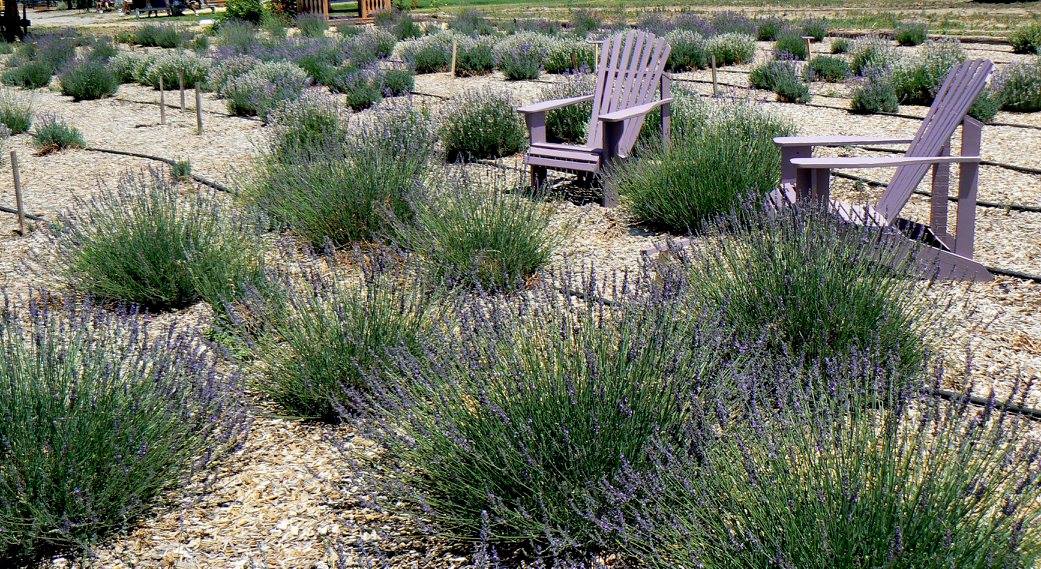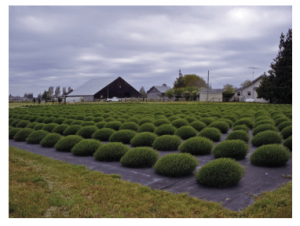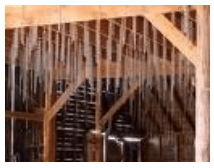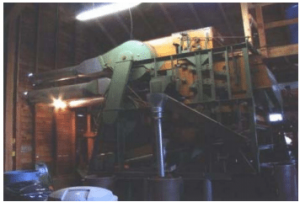
- info@coloradolavender.org
Your Cart
100% Secure Checkout!
No products in the cart.

from October 18th through October 20th, 2008. The conference was presented by the Sequim Lavender Growers Association. According to the organizers, 120 people registered for the conference and it is held every other year. In addition to two days of presentations, we toured three lavender farms, Peninsula Nurseries, Angel Lavender Farm and Sunshine Herb and Lavender Farm, all day Monday in the rain and very cold weather.
The General Session and Keynote Speakers were brothers Paul and Rueben Abbott, owners of the Isle of Wight lavender farm in England. They have been growing lavender and producing lavender based products since 1997. They also frequently show the lavender plants they grow in prestigious garden shows such as the Royal Horticulture Society Chelsea Flower Show. They were the General Session and Keynote speakers in this conference.
Paul covered many aspects of lavender growing, harvesting and marketing. He said the future of lavender breeding is in the dark purple varieties and those with a good fragrance. Because of global warming and increases in summer rainfall, lavender production in England and France has declined because of the prevalence of root rot. Other problems they encounter are rosemary beetles and grasshoppers, which eat the green buds. He noted that the climate has also affected local Sequim growers as well. Because of the production decline in established lavender growing regions, the future of lavender production in the drier regions of Western Colorado looks quite good.
When talking about lavender growing, Paul, Rueben and other speakers all agree on one thing. Start with the end in mind. Choose which plants you want to grow based on what you want to do with them – oil production, dried or fresh bundles, buds, or a U-pick farm for just a few examples. Each one of these situations requires a different set of guidelines. If you want the public to walk through your lavender fields, they should be free of weeds and plants should be far enough apart for people to walk through them. If your fields will be private, weeds might not be as big of a problem. Some varieties of lavender don’t dry well like Provence. This variety is used mostly for fresh bundles. If you plan on selling dried bundles, make sure you have a large enough building in which to dry them in. Lavandins have the longest stems, which are perfect for fresh and dried bundles and lavender wands.
Planning is the most important step for anyone interested in starting a lavender farm. Remember that lavender fills a niche market. Here in Western Colorado, that market needs to be developed and researched. Paul said that commercial lavender plants could be productive for 20 years with professional cutting. In England, he can plant 5,000 plants per acre. It could be similar here but it all depends on which varieties you’re growing and how you will be harvesting the flowers. Lavandins are considerably larger plants than Angustfolias. If you will be harvesting with mechanical harvesters, you need to take that into account when planning your row width. He recommends cutting back by half after blooming in July. This keeps the plant small and tight which is how they like them in England. He also said that lavender is an herb. Like other herbs, they grow bushier and produce more flowers when cut back. Other growing tips were to fertilize lightly if at all with a balanced fertilizer and do not use wood chips around the base of the plant. These hold water that could promote root rot. For the home gardener using lavender in a landscape he dispelled the old myth that lavender is a good companion plant for roses. Because roses are heavy feeders and lavender isn’t, you want to keep the lavender as far away as possible. Excess fertilizer promotes leafy growth in lavender, which dilutes the oils.
On oil production, he said that oils vary by region not necessarily by variety. The soil and climate directly affect the quality and aroma of the oils. Lavandula angustifolia produce the highest quality of oils but the Lavandins produce larger quantities of oil. There is a market for both kinds of oils. Angustfolias are used for essential oils and therapeutic purposes. Lavandin oils can be used for items like soaps, lotions and creams. He also mentioned that Lavandula angustifolia plants growing at high altitudes produce the highest grade of essential oil. Paul said there is a market for essential oil in the United States by large companies like Colgate-Palmolive. Many large companies are using synthetic oils but there is a movement to go back to the real essential oils because of their therapeutic value.
Oregon lavender grower Andy Van Hevelingen also spoke to the attendees. He owns the Van Hevelingen Herb Nursery and sells over 100 varieties of lavender. He has developed 5 unique and popular lavender varieties. He is also a member of the newly formed Oregon Lavender Association. After 2-3 years in existence, they have 14 member growers. He recommended the book The Genus Lavandula as a great reference book that all lavender growers should have. He also mentioned a good newsletter to look into. Its called The Lavender Bag and it comes out twice a year from England.
Andy stressed that there is a lot of confusion over correct names of lavender plants worldwide. Because of this, you may think you are ordering one plant but receive something completely different. Buy from reputable suppliers to be sure of what you’re getting. Between 50-80% of suppliers import their plugs from South America or Israel and they may not always be what they are labeled. When ordering from a supplier, ask if they propagate their own plugs. His nursery propagates all of their own stock.
Andy went on to talk about specific lavender varieties and what they can be used for. The popular lavender wands can only be made from lavandin varieties because they have the longest wands. Melissa is known for its culinary uses. Princess Blue is good for jams and jellies. Provence is good for fresh cut bundles only because it doesn’t dry well. Folgate is an early bloomer and Sharon Roberts is a reliable repeat bloomer. I also heard that Sharon Roberts blossoms smell like peaches.
When discussing lavender growth, Andy said that lavender leaves only last two years. The bottom leaves will develop brown or black spots indicating necrosis, which is a natural process. If you cut the plant back severely after the first bloom it will decrease or eliminate the second bloom. If you want a second bloom, lightly shear the wands off and leave most of the foliage. When harvesting lavender for oil production, Andy said the best time is when 30% of the flowers are brown. This is when all of the floral notes are fully developed. Oil from lavandin varieties will need to cure for 1-2 years for best results.
Susan Harrington of Labyrinth Hill Lavender talked about Internet Marketing and producing results oriented web pages. The Internet marketing session covered topics such as using your current customer list to increase traffic by the use of newsletters and postcards. Using a database program to keep track of your customers was also encouraged. She uses a service called Constant Contact, which helps you get your message out to customers in an easy, effective and affordable way. I have a sample packet with their information. They also have a web page – www.ConstantContact.com She mentioned Blue Moon Lavender as a company that has an especially effective marketing plan.
Cheap Web Tricks by Anne Martinez
Growing a Business by Paul Hawken
The E Myth Revisited by Michael E. Gerber
Think and Grow Rich by Napoleon Hill
Half.com website for used books www.half.com
She also spoke of effective techniques to use when at a craft fair, festival or farmers market booth. Always share your expertise with customers. Share creative ways to use your product and help customers find a way to make money using your product like lavender buds. Always have a demonstration going on while at your booth. Make lavender wands, create a sachet, demonstrate the proper way to propagate lavender. All of these activities draw in customers. Be sure to label your products as locally grown. Customers will feel good about buying locally and it adds value to your products.
WSU Extension Director of Clallam County, Curtis Beus, spoke to the attendees about the all-important issue of agri-tourism. He has helped the Sequim lavender industry from its inception in the early 2000’s. He has also authored two of the best publications on lavender and agri-tourism around. Curtis said that agri-tourism is about direct marketing. You are selling your company and product directly to the customer. Agri-tourism focuses on the experience such as U-pick farms, special occasion venues, demonstrations such as cooking or crafting classes and educational trips. The types of visitors to 4 your farm are endless. Think of school field trips including home schoolers, wedding parties, birthday parties, Ladies Teas and lunches. Create a lavender maze or labyrinths to have people of all ages spend significant time at your farm. Food also keeps the customers at your farm, store or farmers market booth longer.
One thing to consider is the necessity of having liability insurance if you have visitors to your farm. You also need to consider zoning in the area. Make sure that you can have large amounts of cars parking in your area. Be sure you can operate a business in your area. If your farm is in a residential neighborhood, these could be real problems. Signs and signage are other issues to consider. Work with other tourism attractions in the area. Think about combining your event with the Peach Festival or Winefest for example. If you’re creating edible products, work with peach growers or vineyards to use their products and be sure to advertise this to your customers.
Annie Harman taught standing room only crowds all about hydrosols, a product of the distillation process. She owns Morning Myst Botanics and has been studying hydrosols for over 10 years. To produce essential oils or hydrosols, plants are typically steamed. You should use only fresh plant material, not dried. According to Annie, Grosso and Super lavender plants do not produce aromatherapy grade oils. Only angustfolias can be used for therapeutic grade oils. As the steam passes up through the plant material, – bark, stems, roots or fresh or dried flowers (as in the case of lavender) – it carries both the oil and other plant essences into a receiving container. As the distillate cools, essential oil floats to the top and is siphoned away. The liquid left behind is the hydrosol. Hydrosols are gentler on skin than essential oils. Hydrosols are used in the cosmetic industry for creams and lotions. You can substitute a hydrosol for water in any cream or lotion recipe.
These three distillers were demonstrated at the Sunshine Herb and Lavender Farm on Monday, October 20th. The large still was handmade by a local lavender grower using a water heater, furnace unit and lots of stainless steel piping. In addition to processing his own lavender plants, he also distills oils and hydrosols for other area growers. Talking with local growers, I found out there are pros and cons for using stainless steel or copper for the stills. Before buying a distiller, research should be done to make sure you can produce the type of oils and hydrosols you are looking for.


A hydrosol supplier should be able to answer these questions –
1. What botanical species? Lavandula angustifolia Which part of the plant was distilled? Flowers, stems, foliage, all of the above?
2. When was it distilled? Hydrosols are perishable products. Should be used within 1 year of distillation for therapy purposes.
3. Why? What was the purpose of the distillation? Oil or hydrosol?
4. Where? US or import? Preservative free?
5. Weight? Plant – hydrosol ratio 1 pound of plant material = 1-2 pounds of hydrosol 4 pounds of plants = 1 gallon of hydrosol
Good reference books: Hydrosols – The Next Aromatherapy by Suzanne Catty
Chemistry of Aromatherapy Oils by Joy Bowles
Hydrosols and Aromatic Waters by Jeanne Rose
Understanding Hydrolats – The Specific Hydrosols for Aromatherapy By Len Price and Shirley Price
The next speaker was Cathy Lucero, the Clallam County Noxious Weed Control Coordinator. She is every bit as enthusiastic about weeds as Jude Sirota and a pleasure to listen to. It was nice to know that almost everyone in the audience has battled our favorite weed – bindweed – with as much luck that we’ve had. Cathy stressed the need to know as much about the weeds you are battling so you use the right method to get rid of them.
Know the Plant
Interrupt the life cycle
Limit access to resources
Learn new technologies
When you know your weeds you will know that with annuals, you control the seed production. With biennials and perennials, you’ll need to control seed production and root growth. Site preparation is crucial. There is no herbicide labeled safe to use on lavender. Weed fabric in between the rows and around the plants seem to be the most effective weed control for the audience. Integrated Weed Management involves prevention, mechanical, cultural, chemical and biological controls.
Reitha Weeks covered cosmetic regulations, labeling and safety testing and Chef Andre Mercier demonstrated several tasty lavender recipes. I did not attend these break out sessions because they were scheduled at the same time as other sessions I attended.
The first lavender farm we visited on Monday was the Peninsula Nursery where we learned the correct way to propagate lavender and how to plant them. The best time to take cuttings from lavender plants is right after they have bloomed. Take cuttings from stems with no buds on them. Remove leaves from the bottom half of the cutting and insert into well draining potting soil. Rooting hormones are not necessary. Be sure the label and date your cuttings. Water well and mist regularly. They should “take” in about 3 weeks. This is the time you would transplant the cutting into a larger pot, maybe a 3 ½” size.
We also learned all the considerations needed to properly build a hoop house for propagation. Things like making sure the ground in the center of the house is higher than the sides for proper water drainage. Locate the house to take advantage of prevailing winds for good air circulation. Make sure to roof of the house is sloped enough to keep snow from accumulating. When building benches for the plant flats, think about how high they will be with the flats on them, not just bare benches. This becomes important when you have to water the flats everyday and your arms are higher than is comfortable.
These are pictures of Angel Lavender Farm I found on the Internet. The inside of the drying barn behind the lavender field is shown in the small picture. We saw this barn on our tour. These lavender growers hang their lavender bundles to dry on chain link hanging from the ceiling. They also have fans that circulate the air when the lavender is drying.



You can see from these pictures that Angel Farm uses black weed barrier between its lavender plants. When the plants are fully grown and in bloom, you can hardly see the fabric let alone walk between the plants. Also, this picture of the de-budding machine, called the “Jitter bud”, doesn’t do it justice. This machine is amazing. You must walk up two flights of scaffolding just to load the top with lavender buds! The finished product is very clean but Angel Farms puts their buds through 4 times for the cleanest buds I have ever seen.
We visited Sunshine Herb and Lavender Farm to watch distilling operations by a local lavender grower. We also noted how the front “yard” of this business, which fronts onto the main highway through Sequim, was laid out to accommodate visitors during the annual Lavender Festival and all through the year.